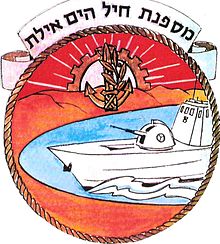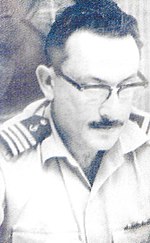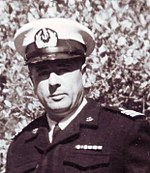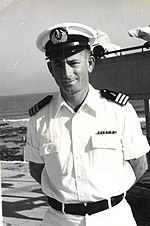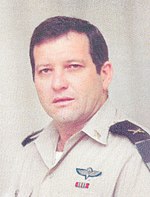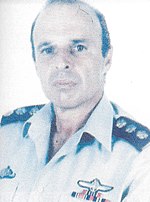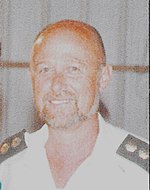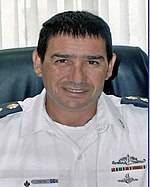Haifa Shipyard
Establishment of British Shipyard
The professional infrastructure in naval engineering in Israel which was used by the navy in its establishment began in the British shipyard in Haifa which operated from the beginning of 1942 and served the British army in handling damaged vessels and adapting them to a military purpose in real time. [7] At the height of its activity, the shipyard employed about 1000 people. Father Khushi expressed its future importance in writing in one of the memos that appear in his archives : "It may be possible after the war to purchase all the equipment and the workshops and it would be appropriate for this factory to be transferred to a trust . "
At that time, World War II was at its peak. Most of the coast of the Mediterranean, except for Turkey and Spain, is under the control of the Axis Powers. The Allies held Egypt, Mandatory Palestine and later Syria and Lebanon. At the end of 1942, within the Haifa Port area, the PWD Public Works Department under the management of the Jewish engineer Peretz Willard Etx [8] erected three or four buildings, some of them made of concrete with tin roofs and some made of wood with tin roofs. The entire complex was surrounded by a high fence and the entrance to it was through a gate for pedestrians and a gate for vehicles identified as gate number 11. The area was highly classified and guarded. The British shipyard in Malta was responsible for the shipyard in Haifa. On December 25, 1942, the shipyard was registered under the company Shipwrights & Engineers ME LTD. [9] [10] [11] [12] The purpose of this company was to conduct marine engineering business in the repair, construction and maintenance of steamships. The senior workers at the shipyard were brought from Malta and their terms of employment were according to the contract in Malta. In Haifa, technical personnel were recruited through the labor office of the Haifa Workers' Council and the employment office of the Arab sector. [13] The manpower was diverse and included carpenters, plumbers , engravers, solders and welders, metal workers, instrument makers, boiler makers, builders and general workers. In addition, manual workers were recruited for "beard scraping" jobs, etc., and most of them were day laborers . The payment to the simple day laborers was daily.
Inside the buildings that were erected for the shipyard were two halls where the maritime professionals worked and where they repaired parts of ships that were damaged. A floating probe was brought from Malta which was the only one in the port. From time to time, special work tools were brought from there to repair ships. The shipyard worked seven days a week on Saturdays and holidays and fully responded to the needs of the Royal Navy. In one case the shipyard converted a cargo ship into a passenger ship and the ship was the Tripolitania.
The shipyard's offices were located in Haifa at the offices of HAIFA SHIPPING AGENCY LTD on 82 Malkim Street in one of the Aziz Khayat buildings . One of the shipyard's employees was the engineer Levy, whose daughter Hana Levy worked in the shipyard's secretariat. The chief secretary of the shipyard was Rebecca Watson, the wife of Lionel Watson, the engineer of the city of Haifa. The engineer Aryeh Gutesman was the chief foreman. Aryeh Mehulel was the director of the labor department and his title was Chief Time Keeper, Aryeh who was a man of the Echelon was pulled from the shipyard by the CID, arrested at his home on March 2, 1944, and exiled to Eritrea .
On July 30, 1945, a notice was published in the official newspaper of the Palestine government (The Palestine Gazette in the English edition), issue number 1424, regarding the voluntary liquidation of the company and John Cuthbert Kochs was appointed liquidator. The floating test was returned to Malta.
Construction of Israeli Shipyard
The core of the professional workforce for the construction of the Israeli Navy shipyard infrastructure came from three professional bodies:
A company Shipwrights & Engineers operated in Mandatory Palestine to repair ships of the British military fleet and the commercial fleet. The company ceased its activities in Israel at the end of World War II. The company employed professionals from the settlement who in this way acquired their experience working in ship repair and workshop management.
A new company, "Haifa Engineering Factories"- Kirstein & Grinshpon started operating in Israel. [18] Kirstein was a qualified engineer for marine engineering, who became the expert of the British Royal Navy in all naval ship repairs in the Middle East. [19] When the Shipwrights & Engineers left, the Israeli workers, moved to the Kirstein & Grinshpon company, which developed and took over most of the shipping work in Israel. A large workshop was opened at the intersection of Sderot, Ha-Histadrut and Kfar-Ata. Before that, the name of this intersection was "Pilar Locomotive". After the War of Independence, Kirstein & Grinshpon entered into a partnership with " Soll Bona ", and "Hima" was established. [20] The "Hima" company was the precursor of "Israel Shipyards".
The Kirstein & Greensphon factory worked for the "Haganah", and its main work was in the production of mines, grenades, mortar bombs, mortars and armored vehicles. In addition, the factory built small naval vessels. [21]
Ship conversions
During the Israeli war of Independence, the workforce at the Kirstein & Greensphon factory worked under economic lockout orders. During the day they worked in the factory, and during the night the workers went on guard and security duties. At the same time, as part of the effort to occupy the Hebrew labor in the Port of Haifa, the members of the port company arrived with Yohai Ben Nun and a group of professionals was formed in preparation for the process of converting the civilian ships of the Shadow Fleet into the first naval ships. From intelligence reports that reached the "Hagana" , they learned of the intention of the British, who were still in control of the port even though they had evacuated the country, to blow up the ships and close the port. This information reached Israel as early as 1946 but later proved to be false. [22]
Amidst fears that British authorities would sink ships in the port of Haifa, the shipyard workers took them out of the harbor and dismantled everything essential to the operation of the ship. The equipment was hidden somewhere in the port. The 'Wedgwood' and the 'Hagana' were steamships, therefore all the pressure gauges, the rudder, everything that could be disassembled was disassembled from them so that it would be impossible to take the ships out independently, but only to tow them. In this way, the possibility of drowning in the middle of the sea was neutralized. When the British left the port the ships were reassembled and smuggled out of the port, of which three large ships were of Eilat (a -16) class, named the " State of the Jews ", the " Regius" and the " Hagana ". [23]
In 1957, Colonel Aryeh Kaplan "Kippi" saw that there was one old ship left in the port and it was the "Nevertheless". With the help of the anchor company and the naval shipyard, the ship was cut into 4 parts and was moved to its designated place as a museum. [19]
The establishment of the shipyard
The initial recruitment for the Israeli Navy was conducted at 29 Jaffa Street by the head of personnel of the naval services, Shlomo Jacobson, [24] from the Yishuv volunteers for the British Royal Navy . Jacobson referred the navy volunteers to the navy, many of the Royal Navy personnel were professionals and with a background of an organized war navy and the initial technical avenue in the navy was formed. [25]
The naval shipyards were established at the initiative of Joe Novek, a Yishuv volunteer for the British Royal Navy. The beginning of the shipyard was at the intersection of Sderot al-Malikim and the German colony where the workshops of the British Public Works Department were situated. The first shipyard workers were Joe Novick and five Yishuv volunteers. The shipyard's initial equipment came from the collection of a variety of equipment from Arab workshops that were abandoned in Haifa during the Israeli War of Independence. The initial camp in the Haifa area was at Hoof Shemen and later he was located at the Haifa naval base in Bat Galim.
With the growth of the shipyard and the workshops, the need arose for a large and orderly building in the port. Warehouse building 4 was bombed by the Egyptians, therefore the Port Authority offered this destroyed building to the Israeli Navy as the shipyard site. The engineering personnel moved to the workshops in the Port of Haifa near the customs house in warehouse 4 near the entrance to the fuel dock. Most of the manpower was from civilian workshops and without an understanding of the professional organizational side of a shipyard as well as an understanding of the structure and requirements of a military shipyard. There was a shortage of manpower and Joe Novick realized that he would not accept soldiers for the shipyard, so he recruited civilians with relevant professions, who became civilian Israel Defense Forces (IDF) workers at the shipyard.
Beyond that, there was a need to establish professional bodies such as electrical department, electronics department, ship hull workshop, damage control, carpentry, underwater work, instrumentation.
The following five officers [26] from the Yishuv volunteers to the British Royal Navy came to fill these positions :
In addition, following volunteers also came:
- Shmuel Winterfeld - electrical trains for transport
- Izzy Moser - Israeli Navy officer
- Jacob Krauss - Ship Workshop
Dick Rosenberg came to the Electronics Division from the United States Navy. He was trained as an artillery officer and was assigned to become a liaison officer [27] later a professor at the Technion in the Faculty of Industry and Management on the subject of behavioral sciences and Rusk who returned to the United States. [28] [29] [30] [31]
The engineering and inspection officer headquarters came from the Yishuv volunteers to the British Royal Navy such as Luther an electrical engineer, Messinger a mechanical engineer, Edmond Wilhelm Brillant a mechanical engineer, Thorpe an electrical engineer.
With the arrival of Paul Shulman, other professionals arrived from the United States Navy and received appointments in the Israeli Navy, for example Jonathan Lev [32] an United States Naval Academy graduate was entrusted with the naval gunnery. [33] Philip Strauss with the inspection of the machinery departments of the ships at sea and the engineering division on the shore, Haim Gershoni was appointed supervisor of shipyard operations and the position of corrections officer. [34] During the conversion of the qualifying ships into a makeshift war fleet, friction arose between Gershoni and Joe Novick. One of the cases that caused friction between Gershoni and Novik was the installation of cannons on the ships of the Shadow Fleet. Napoleonics were Italian cannons from 1912, these were the first cannons that were able to be bought in Italy at the end of 1948. [35] and these were the cannons that were assembled. Four such guns arrived, and they had to be mounted on the corvettes, Wedgwood and Haganah. The cannons were assembled from improvised materials found in Israel, and a week later the cannons were assembled. Due to the circumstances Gershoni left and later described this period in his autobiographical book The Way it Was. [36]
Qualified engineers who were officers came from the US Navy. Among them Robert Allen [37] [38] who was a ship engineer certified by Webb Institute [39] in New York and MIT, decided to stay in Israel. He settled in Haifa with his wife and son and received Israeli citizenship. Alan advanced to the position of head of the naval architecture branch in the Ministry of Defense (Israel) at the rank of lieutenant colonel. In 1956 the family decided to leave Israel.
Establishment of Hall
In 1950, the Navy wanted to invite the prime minister of Israel, David Ben-Gurion, to the graduation ceremony of the recruits. The prime minister expressed his willingness to come but the security, ruled out the Palace Cinema for security reasons emphasizing arrangements in a naval installation. So the shipyard built a hall measuring one hundred and twenty by thirty metres (394 by 98 ft). The hall where the ceremony took place was called "David" barracks after the prime minister in whose honor it was built. [21]
Suez Crisis
During the Suez Crisis, a major operations of the shipyard was the transfer of torpedo ships on carriers from Haifa to Eilat. Moreover, an Egyptian destroyer, Ibrahim Al Awwal, was captured and towed to the Port of Haifa and was restored by the navy's shipyard and its name was K-38 AHI Haifa.
Six Day War
On the eve of the Six Day War, the shipyard very quickly finished the renovations of the destroyer Eilat [40] which returned to service after the INS Haifa (K-38) had ceased to be active. [41]
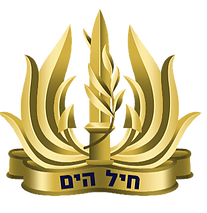
The Israeli Navy is the naval warfare service arm of the Israel Defense Forces, operating primarily in the Mediterranean Sea theater as well as the Gulf of Eilat and the Red Sea theater. The current commander in chief of the Israeli Navy is Aluf David Saar Salama. The Israeli Navy is believed to be responsible for maintaining Israel's offshore nuclear second strike capability.

The Sa'ar 4.5-class missile boats is a class of Israeli Sea Corps missile boats designed and built by Israel Shipyards Ltd. for Shayetet 3 flotilla as an improved and stretched Sa'ar 4-class missile boat. There are two different subclasses that are both named Sa'ar 4.5. The first subclass was initially called Chochit, but renamed to Aliya. Two Aliya-subclass boats are in service with the Mexican Navy. The second subclass was initially called Nirit but renamed to Hetz.
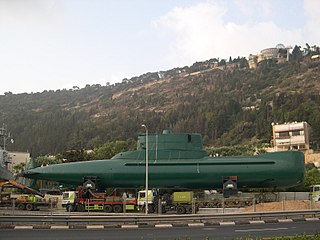
The Type 540 Gal-class submarine is a slightly modified variant of the German HDW Type 206 submarine class, modified for Israeli requirements. The Gal class submarines were built to Israeli specifications as the Vickers Type 540 at the Vickers shipyards in Barrow-in-Furness in the UK rather than Germany for political reasons. "Gal" was the name of the son of Abraham (Ivan) Dror, 3rd commander of the squadron and head of the project.

The Port of Haifa is the largest of Israel's three major international seaports, the others being the Port of Ashdod, and the Port of Eilat. Its natural deep-water harbor operates all year long and serves both passenger and merchant ships. It is one of the largest ports in the eastern Mediterranean in terms of freight volume and handles about 30 million tons of cargo per year. The port employs over 1,000 people, rising to 5,000 when cruise ships dock in Haifa. The Port of Haifa lies north of Haifa's downtown quarter on the Mediterranean and stretches to some three kilometres along the city's central shore with activities ranging from military, industrial, and commercial next to a nowadays-smaller passenger cruising facility.

The Port of Eilat is the only Israeli port on the Red Sea, located at the northern tip of the Gulf of Aqaba.

HMS Zealous was a Z-class destroyer of the Royal Navy built in 1944 by Cammell Laird. She served during the Second World War, participating in operations in the North Sea and off the Norwegian coast, before taking part in some of the Arctic convoys. She spent a further ten years in Royal Navy service after the end of the war before being sold to the Israeli Navy, which operated her as INS Eilat. She saw action during the Suez Crisis in 1956 attacking Egyptian ships, and was still active by the outbreak of the Six-Day War in 1967. She was sunk several months after the conflict by missiles launched from several small Egyptian missile boats; this made her the first vessel to be sunk by a missile boat in wartime. It was an important milestone in naval surface warfare, which aroused considerable interest around the world in the development of small manoeuvrable missile boats.

The 193 Squadron of the Israeli Air Force (IAF), also known as the Maritime Helicopters Squadron and operates on behalf of the Israeli Navy.
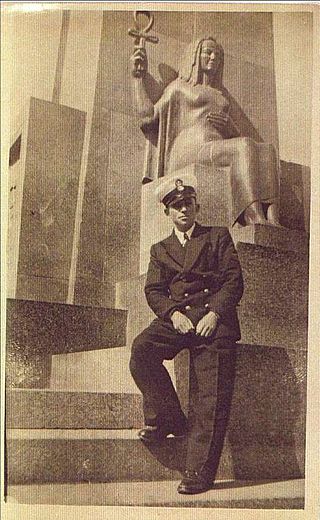
Edmond Wilhelm Brillant Halevi was a Polish-born Israeli naval architect and one of the founding fathers of the Israeli navy.
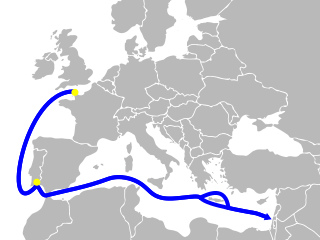
The Cherbourg Project was an Israeli military operation that took place on 24 December 1969 and involved the escape of five remaining armed Sa'ar 3 class boats from the French port of Cherbourg. The boats had been paid for by the Israeli government but had not been delivered due to the French arms embargo in 1969. The whole operation was planned by the Israeli Navy, and was codenamed Operation Noa, after the daughter of Captain Binyamin "Bini" Telem.

Israel Shipyards is a large shipbuilding and repair facilities in the eastern Mediterranean. The company also operates a privately owned port in Israel. The company's facilities are located at the Kishon Port.

Benjamin Telem was the 9th Commander of the Israeli Navy (1972–1976).
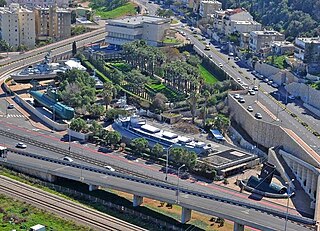
The Clandestine Immigration and Naval Museum is a technical history museum located in Haifa, Israel.

In Israel, Navy Day is celebrated on June 30. At this time in 1948 the Port of Haifa was captured by Israel during the 1947–1949 War of Independence/Palestine War. Traditionally, Navy Day is preceded by Memorial Evening.

David Saar Salama is an IDF Major General (Aluf) who currently serves as the commander of the Israeli navy.

The Missile Ship Fleet, or as it's officially called Shayetet 3, is the main surface combat force of the Israeli Navy. The fleet was established in 1967 and includes, 15 missile ships of the Saar 4.5, Saar 5 and Saar 6 models. In addition, the Ahi Bat Yam auxiliary ship is under its command. It is the only fleet of Israeli Navy operating Surface vessels

Eilat Naval Base is a major Israeli naval base situated in the Israeli coastal city of Eilat. It was established in 1949 and serves to be the sole Israeli Navy Base on the coast of Red Sea.

Shayetet 7 is the only submarine flotilla of the Israeli Navy. It is based in Haifa naval base and operates Dolphin-class submarines. It was established in 1959 and is considered an elite unit due to the nature of its services.

Ashdod Naval Base also known as Southern Arena of the Israeli Navy is a naval base located in the port city of Ashdod near the Port of Ashdod and plays an important role in the surveillance and blockade of Gaza strip as well as protecting the Port of Ashdod.

BHD 600 or Haifa naval training base is the sole naval training base of the Israeli Navy. It is located in the port city of Haifa and is responsible for the training of most of Israeli Navy personnel.

Mount Carmel Naval Base officially known as Betzat is the main logistical base of the Israeli Navy located near the Mount Carmel. It is responsible for all equipment and transport related activities of Israeli Navy.


